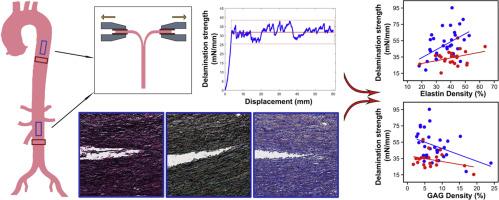Effects of age, elastin density, and glycosaminoglycan accumulation on the delamination strength of human thoracic and abdominal aortas
IF 9.4
1区 医学
Q1 ENGINEERING, BIOMEDICAL
引用次数: 0
Abstract
Aortic dissection is a life-threatening condition caused by layer separation. Despite extensive research, the relationship between the aortic wall's structural integrity and dissection risk remains unclear. Glycosaminoglycan (GAG) accumulation and elastin loss are suspected to play significant roles. We investigated how age-related changes in aortic structure affect dissection susceptibility. Peeling tests were performed on longitudinal and circumferential thoracic (TA) and abdominal aortic (AA) strips from 35 donors aged 13–76 years (mean 38 ± 15 years, 34 % female). GAG, elastin, collagen, and smooth muscle cell (SMC) contents were assessed using bidirectional histology. Young TAs resisted longitudinal peeling better than circumferential, with delamination strengths of 65.4 mN/mm and 44.2 mN/mm, respectively. Delamination strength decreased with age in both directions, more rapidly longitudinally, equalizing at ∼20–25 mN/mm in older TAs. Delamination strength in AAs was 22 % higher than in TAs. No sex differences were observed. GAG density increased, while elastin density decreased by 2.5 % and 4 % per decade, respectively. Collagen density did not change with age, while SMC density decreased circumferentially. GAGs partially mediated the reduction in longitudinal delamination strength due to aging, while circumferential strength reduction was not mediated by changes in either GAG or elastin densities. This study explains why aortic dissections are more common in TAs, especially in older individuals, and why they typically propagate spirally. TAs exhibit lower delamination strength compared to AAs and experience strength reduction with age, a phenomenon linked to increased GAG accumulation and elastin loss. These findings enhance our understanding of the pathophysiological mechanisms behind aortic dissection.
Statement of significance
This work explores the age-dependent relationships between delamination strength in human aortas and wall structural content. We investigated 35 human aortas from donors aged 13 to 76 years, providing new insights into the biomechanical and histological factors that influence aortic dissection risk. Our findings elucidate how variations in elastin, glycosaminoglycan, collagen, and smooth muscle cell densities impact the structural integrity of the aorta, contributing significantly to the understanding of aortic dissection mechanisms.

年龄、弹性蛋白密度和糖胺聚糖积累对人体胸腹主动脉分层强度的影响
主动脉夹层是一种因层间分离而导致的危及生命的疾病。尽管进行了大量研究,但主动脉壁结构完整性与夹层风险之间的关系仍不清楚。人们怀疑糖胺聚糖(GAG)的积累和弹性蛋白的流失起到了重要作用。我们研究了主动脉结构中与年龄相关的变化如何影响夹层的易感性。我们对 35 名年龄在 13-76 岁(平均 38 ± 15 岁,34 % 为女性)的供体的胸主动脉(TA)和腹主动脉(AA)纵向和环向切片进行了剥离测试。采用双向组织学方法评估了凝胶体、弹性蛋白、胶原蛋白和平滑肌细胞(SMC)的含量。年轻 TA 的纵向抗剥离能力优于周向,分层强度分别为 65.4 mN/mm 和 44.2 mN/mm。随着年龄的增长,两个方向的分层强度都有所下降,纵向下降更快,在年龄较大的 TA 中,分层强度在 20-25 mN/mm 之间持平。AA 的分层强度比 TA 高 22%。没有观察到性别差异。凝胶体密度增加,而弹性蛋白密度每10年分别下降2.5%和4%。胶原蛋白密度不随年龄变化而变化,而SMC密度则呈圆周性下降。GAGs 在一定程度上介导了老化导致的纵向分层强度的降低,而周向强度的降低并不介导于 GAG 或弹性蛋白密度的变化。这项研究解释了为什么主动脉夹层在 TA 中更为常见,尤其是在老年人中,以及为什么主动脉夹层通常呈螺旋状传播。与 AAs 相比,TAs 表现出较低的分层强度,并且随着年龄的增长强度降低,这种现象与 GAG 积累增加和弹性蛋白流失有关。这些发现加深了我们对主动脉夹层背后病理生理机制的理解。意义说明:这项研究探讨了人体主动脉分层强度与壁结构含量之间随年龄变化的关系。我们研究了 35 例人体主动脉,捐献者的年龄从 13 岁到 76 岁不等,从而对影响主动脉夹层风险的生物力学和组织学因素有了新的认识。我们的研究结果阐明了弹性蛋白、糖胺聚糖、胶原蛋白和平滑肌细胞密度的变化如何影响主动脉的结构完整性,这对理解主动脉夹层的机理大有帮助。
本文章由计算机程序翻译,如有差异,请以英文原文为准。
求助全文
约1分钟内获得全文
求助全文
来源期刊

Acta Biomaterialia
工程技术-材料科学:生物材料
CiteScore
16.80
自引率
3.10%
发文量
776
审稿时长
30 days
期刊介绍:
Acta Biomaterialia is a monthly peer-reviewed scientific journal published by Elsevier. The journal was established in January 2005. The editor-in-chief is W.R. Wagner (University of Pittsburgh). The journal covers research in biomaterials science, including the interrelationship of biomaterial structure and function from macroscale to nanoscale. Topical coverage includes biomedical and biocompatible materials.
 求助内容:
求助内容: 应助结果提醒方式:
应助结果提醒方式:


